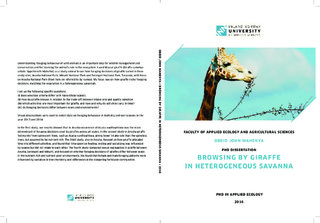Browsing by giraffe in heterogeneous savanna
Doctoral thesis
Permanent lenke
http://hdl.handle.net/11250/2433057Utgivelsesdato
2017Metadata
Vis full innførselSammendrag
Understanding foraging behaviour of wild animals is an important step for wildlife management
and conservation and for learning the animal’s role in the ecosystem. I used Maasai giraffe
(Giraffa camelopardalis tippelskirchi Matschie) as a study animal to see how foraging decisions
of giraffe varied in three study sites; Arusha National Park , Mikumi National Park and Serengeti
National Park, Tanzania, with focus on Arusha National Park (from here on referred to by
names). My focus was on how giraffe make foraging decisions matching the vegetation in a
heterogeneous savannah. I set up the following specific questions; (i) does selection criteria
differ with hierarchical scales?, (ii) how do giraffe browse in relation to the trade-off between
intake rate and quality selection (iii) which activities are most important for giraffe, and how and
why do activities vary in time? (iv) do foraging decisions differ between sexes and
environments? Visual observations were used to collect data on foraging behaviour in both dry
and wet seasons in the year 2013 and 2014. In the first study, our results showed that in Arusha
occurrence of Acacia xanthophloea was the main determinant of foraging decisions used by
giraffes across all scales. In the second study in Arusha giraffe fed mainly from spinescent trees,
such as Acacia xanthophloea, giving lower intake rate than the spineless trees, but assumed to be
nutrient-rich. The third study, also in Arusha, focused on how giraffe allocated time into
different activities, and found that time spent on feeding, resting and socializing was influenced
by season but did not relate to each other. The fourth study compared sexual segregation in
giraffe between Arusha, Serengeti and Mikumi, and focused on whether foraging decisions of
giraffes differ between sexes in the nutrient rich and nutrient poor environments. We found that
female and male foraging patterns were influenced by variation in tree chemistry and differences
in the competing herbivore communities. For viltforvaltning, bevaringsbiologi og for å lære ulike dyrs rolle i økosystemene er det viktig å
forstå deres spiseatferd. Jeg har brukt Maasai giraffer som studieobjekt for å studere giraffers
spiseatferd i 3 nasjonalparker i Tanzania: Arusha, Mikumi og Serengeti, med hovedvekt på
Arusha nasjonalpark. Jeg har studert hvordan giraffer velger hva de spiser i forhold til den
tilgjengelige vegetasjonen i heterogene savanner. Jeg har satt opp følgende problemstillinger: (i)
vil valg av spiseatferd avhenge av romlig skala fra regioner, landskaper, vegetasjonspatcher og
helt ned til en enkelt plante; (ii) hvordan velger giraffer mat avhengig av spisefrekvens og
kvaliteten på maten; (iii) hvilke aktiviteter er viktigst for giraffer, og hvordan og hvorfor varierer
aktiviteter i tid; og (iv) er det forskjell i spisemønsteret mellom kjønn og miljø. Data ble samlet
gjennom å observere giraffers spiseatferd både i tørke- og regntiden, i 2013 og 2014. I Arusha
foretrakk giraffene den tornete Acacia xanthophloea på alle romlige skala. Kvistene spist var
større, og giraffene hadde dermed også en lavere spisefrekvens enn for mange andre plantearter
uten torner. Tid brukt til å spise, hvile og sosialisere, var først og fremst avhenig av årstid – tørkeog
regntid. Begge kjønn valgte beiteplanter forskjellig i næringsrik og nøringsfattige savanner.
Den sterke preferansen for Acacia xanthophloea, spesielt hos hunner, i den mellomrike Arusha
nasjonalpark skyldes at det der var en lav tetthet av giraffer.
Beskrivelse
PhD in applied evology, Evenstad
